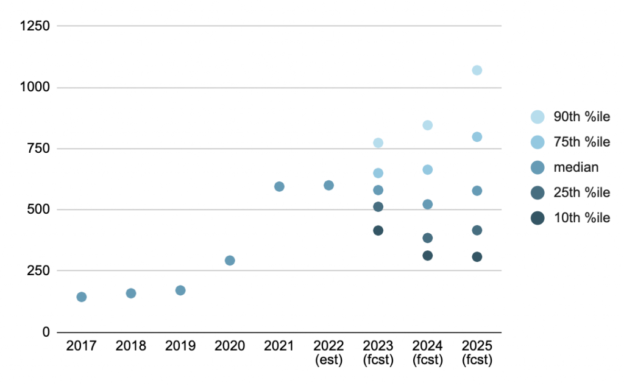This year, Open Philanthropy plans to give $300 million for GiveWell to spend over the next three years. We’re grateful for what this support will enable us to do.
Annualized, this is similar to what Open Philanthropy gave in 2020 and roughly in line with what we projected earlier this year. It’s less than Open Philanthropy gave in 2021 and 2022, and we’ll need strong growth in donations in order to make up the difference.1This refers to funds raised for the programs we recommend. As an organization, we’re in a very stable position financially. jQuery(‘#footnote_plugin_tooltip_14366_1_1’).tooltip({ tip: ‘#footnote_plugin_tooltip_text_14366_1_1’, tipClass: ‘footnote_tooltip’, effect: ‘fade’, predelay: 0, fadeInSpeed: 200, delay: 400, fadeOutSpeed: 200, position: ‘top right’, relative: true, offset: [10, 10], }); We expect to identify more great funding opportunities than we’ll be able to fund, and your support can fill those cost-effective gaps, helping to save and improve people’s lives.
Below, we share:
How this update affects GiveWell’s work (more)
More background on Open Philanthropy and GiveWell’s relationship (more)
Why Open Philanthropy’s spending is changing (more)
The impact donors can have by supporting GiveWell’s recommendations (more)
How Open Philanthropy’s giving affects GiveWell’s work
Open Philanthropy’s funding of $300 million over three years is roughly in line with what we were expecting in April 2023 and is a decrease from what we expected a couple years ago.2It’s between the 25th and 50th percentile outcomes we anticipated in our post, which was informed by ongoing conversations with Open Philanthropy about its likely giving. jQuery(‘#footnote_plugin_tooltip_14366_1_2’).tooltip({ tip: ‘#footnote_plugin_tooltip_text_14366_1_2’, tipClass: ‘footnote_tooltip’, effect: ‘fade’, predelay: 0, fadeInSpeed: 200, delay: 400, fadeOutSpeed: 200, position: ‘top right’, relative: true, offset: [10, 10], }); In 2021, we scaled up our efforts to find more funding opportunities in expectation of potentially reaching $1 billion in funds raised by 2025. While we no longer project raising $1 billion in 2025, our research team has risen to the challenge and has found more cost-effective funding opportunities than we expect we’ll be able to fund.
Open Philanthropy isn’t yet sure what level of funding it might provide for GiveWell’s recommendations after 2025, if it renews its support. Our outreach team is ramping up its fundraising efforts so that we can help as many people as possible, and we expect to support hundreds of millions of dollars worth of outstanding programs regardless of Open Philanthropy’s funding

